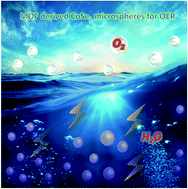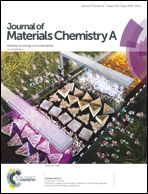MOF-derived CoSe2 microspheres with hollow interiors as high-performance electrocatalysts for the enhanced oxygen evolution reaction†
Abstract
Electrocatalytic water splitting has been recognized to be one of the most promising routes to acquire hydrogen. However, the high-efficiency water splitting is limited by the sluggish kinetics of the anodic oxygen evolution reaction (OER). Metal–organic frameworks (MOFs) have been extensively utilized as precursors to synthesize high-performance electrocatalysts. Herein, a facile template-engaged strategy is adopted to fabricate hollow microspheres derived from a Co-MOF. After a thermally induced selenylation process under an argon atmosphere, the Co-MOF is successfully converted into CoSe2 microspheres at different temperatures. The optimized CoSe2-450 microspheres display excellent OER electrocatalytic performance in 1.0 M KOH aqueous solution, exhibiting 10 mA cm−2 at η = 330 mV with a small Tafel slope of 79 mV dec−1, even superior to those of a commercial IrO2 catalyst. Moreover, CoSe2-450 shows excellent durability without obvious decay after 1000 cyclic voltammetry cycles. This is due to the hollow interior of CoSe2 microspheres and well-distributed active sites, which can effectively offer space for fast mass transport and electron transfer.

- This article is part of the themed collection: 2017 Journal of Materials Chemistry A HOT Papers


 Please wait while we load your content...
Please wait while we load your content...